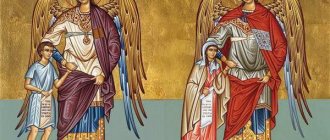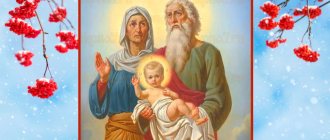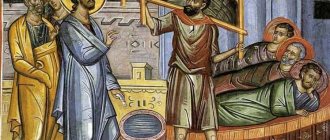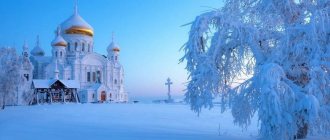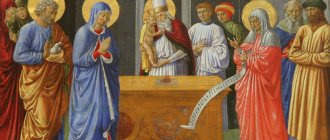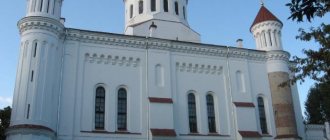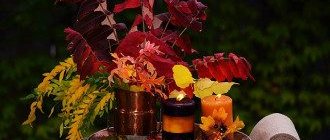On December 17, Orthodox Christians celebrate the day of remembrance of the Holy Great Martyr Barbara, who suffered in 306 during the reign of Emperor Maximian.
The rector of the Kiev-Pechersk Lavra, Metropolitan of Vyshgorod and Chernobyl, Vladyka Pavel, told Vesti readers about the holiday.
St. Nicholas Day in Ukraine: what not to do on this day and what to do
Life of the Holy Great Martyr Barbara
The Holy Great Martyr Barbara lived in the 3rd century in the city of Iliopolis in Phoenicia. Her father Dioscorus was a representative of the aristocracy in Asia Minor under the emperor Maximian (c. 250-310). Varvara was very pretty, and her father locked her in a tower to hide the girl from prying eyes. During her imprisonment, Varvara, studying the world around her, which she could see from the windows, came to the idea of the existence of a single Creator of all living things. Wanting to marry off his daughter, Dioscorus allowed Barbara to leave the tower. Then she met the Christians of Iliopolis and was baptized.
When Dioscorus learned about his daughter's Christian baptism, he became angry and took his daughter to Maximian. They tried to persuade Varvara to renounce the Christian faith. But she was adamant. Then she was subjected to cruel torture: she was scourged with ox sinews, her wounds were rubbed with hair shirt, and she was scorched with fire. Maximian gave the father the right to put his daughter on trial. The pagan Dioscorus became the executioner of his daughter: he beheaded Saint Barbara. Later, Dioscorus and Maximian suffered retribution, both of them were burned by lightning. Together with Saint Barbara, Saint Juliana was executed, who declared herself a Christian during the torture of Saint Barbara.
Library of the Russian Faith Life of the Holy Great Martyr Barbara. Great Menaion of Cheti →
Read online in original
What do they ask the great martyr for?
- About protection, patronage.
- About not giving your soul to God without communion. They also pray in front of the icon for relatives who died without having time to confess and receive communion.
- About help for headaches, head injuries, before surgery (since the girl suffered many blows to the head and other torture).
- About improving understanding in the family (especially between growing children and parents).
- About getting rid of sadness and melancholy caused by betrayal (since during her life she was betrayed by her only relative - her father).
Veneration of the Holy Great Martyr Barbara
A certain pious man, Valentinian, took the remains of Barbara and Juliana and buried them in the village of Gelasia, located 12 miles from Euchaitis in Paphlagonia. A temple was erected on this site, and the relics of the saints healed those suffering from leprosy. The monastery dedicated to Barbara was located in Edessa. In Constantinople, in the Basilisk quarter, Virina, the widow of the Byzantine emperor Leo the Great (390–461), had a temple built in her honor. In the 6th century, the relics of Barbara were transferred to Constantinople and placed in this temple. Here, according to the Synaxarion of the Church of Constantinople, the annual celebration of her memory was solemnly celebrated. In Constantinople, several more churches are known in honor of the Great Martyr Barbara, one of them was located in the southern part of the main Constantinople street Mesa, between the forums of Taurus and Constantine. Another temple was located in Mangany, near the gate of St. Barbara.
From the “Chronicon” of Andrea Dandolo (1305–1354) it is known that most of the relics of the Great Martyr Barbara were presented to the Doge of Venice on the occasion of the marriage of his son Giovanni Orseolo with Maria Argiropulina, a relative of the Byzantine Emperor Basil II the Bulgarian Slayers (958–1025) and sister of Emperor Romanos III Argir (968–1034). In the 6th century, the relics of the Holy Great Martyr Barbara were transferred to Constantinople. According to legend, in 1108, Princess Varvara Komnena, the daughter of the Byzantine emperor Alexei I Komnenos (1056/1057 - 1118) and the wife of the Grand Duke of Kiev Svyatopolk II (Mikhail) Izyaslavich (1050-1113), before leaving for Rus', asked for gift from his father of the relics of the Holy Great Martyr Barbara. Grand Duke Svyatopolk Izyaslavich, who built a stone church a year earlier in Kyiv, placed the relics of the great martyr there with honor and founded the St. Michael's Golden-Domed Monastery. During Batu's invasion, the relics were hidden and then returned to their original place.
Reliquary with the relics of the Holy Great Martyr Barbara in the Golden-Domed Monastery. Photo from 1872
In 1644, under the Kiev Metropolitan Peter Mohyla (1596/1597 - 1647), part of the finger of the great martyr was given to the Chancellor of the Kingdom of Poland Georgy Osolinsky. During the same period, the left hand, which had been in Greece for a long time, was transferred to the city of Lutsk, where it was placed in the monastery church in honor of the Exaltation of the Holy Cross. In 1650, the great Lithuanian hetman Janusz Radziwill (1612–1655), having taken Kyiv by storm, received two particles of relics from his fingers and from his rib. Part of the fingers went to his wife, and then to the Kyiv Metropolitan Joseph of Tukalsky (d. 1675), and after his death it ended up in the city of Baturin, in the monastery of St. Nicholas, where the relics were revered as exuding miraculous healings. In 1656, the Kiev Metropolitan Sylvester (Kossov; late 16th / early 17th centuries - 1657) transferred part of the relics to the Patriarch of Antioch Macarius III (d. 1675). During the destruction of the Golden-Domed St. Michael's Monastery in the 1930s, the relics of the Holy Great Martyr Barbara were confiscated and transferred to the museum. Currently, they rest in the Vladimir Cathedral in Kyiv, which belongs to the Ukrainian Orthodox Church of the Kyiv Patriarchate. The left foot of the Holy Great Martyr Barbara is located in the St. Barbara Cathedral in Edmonton (Canada), since it was taken from Kiev in 1943 by Bishop Panteleimon (Rudyk; 1898 - 1968), who served in Canada since 1952.
Varvara's Appeal
Rich suitors began to come to Dioscorus, asking for his daughter’s hand in marriage. But Varvara refused everyone. Her father decided it was time to let her out of the tower so she could see how happily married her peers were.
When Varvara came out of captivity, she met Christian girls who told her about the Creator and His Only Begotten Son. When Dioscorus was away, Varvara invited a priest who taught her the basics of the Christian faith and secretly baptized her .
At that time, a bathhouse with two windows was being built in my father’s house. But the girl ordered the workers to make a third window. Then she drew the sign of the cross on the marble with her finger, which appeared as if carved out with iron. Also on the stone was the imprint of Varvara’s foot, from which a source gushed. Since then, people have been healed by this holy water.
When Dioscorus returned, he saw that there were three windows in the bathhouse. He asked the workers in anger, they replied that his daughter told them to do so. When he demanded an answer from her, Varvara said that she had ordered three windows to be made in memory of the Holy Trinity. She also pointed out to him the cross she had drawn on the stone.
Dioscorus, having learned that his daughter had become a Christian, flared up with anger and grabbed a sword to kill her right there. But she ran away from him and hid in a cave. At that time there were two shepherds there who saw her. Dioscorus asked them where the girl ran. One of the shepherds said that he did not see anyone, and the other pointed to the cave where Varvara hid. For this, the shepherd turned into a stone pillar, and his sheep into locusts.
The Torment of Saint Barbara
Dioscorus found his daughter in a cave and began to brutally beat her. Then he dragged her home by her hair. There he imprisoned Varvara in prison and did not order her to be given water or food. After several days of imprisonment, the father decided to take Varvara to the ruler Martian, a persecutor of Christians.
Dioscorus told him that his daughter believed in Christ. Martian saw Varvara, was surprised by her beauty and began to persuade her to regret her youth, renounce Christ and sacrifice to idols. But Varvara boldly replied that she would never do this.
Then the ruler ordered Varvara to be undressed. Standing naked in front of a crowd of people was torture for a chaste girl. Then he ordered her to be beaten with iron rods so that the whole ground turned red with her blood.
Then they began to torment the martyr’s wounds with shards and rub them with hair shirt. But Varvara did not give up. She was thrown into prison overnight to come up with the worst possible punishment. In prison, Christ appeared to her and healed her wounds. A certain woman named Juliana watched Varvara’s suffering, followed her and looked out the window of the dungeon where she was. She also wanted to become a martyr for Christ and she prayed that God would strengthen her .
In the morning, Varvara was taken out of prison and taken to the ruler. Juliana followed. The ruler told her to thank the gods who healed her. To this Varvara replied that it was not idols, but Christ who healed her. The angry tormentor ordered the girl to be hanged from a tree, whittled with iron claws and the wounds burned with candles. Then they started hitting her on the head with a large hammer.
Juliana, observing the torment of Varvara, began to loudly reproach the tormentor. Then they hung her nearby and began to whittle her with their claws. After this, Juliana was thrown into prison, and Varvara was led naked through the city, beaten and humiliated.
Varvara prayed fervently, and an Angel was sent to her, who covered her nakedness with light clothes. After this, the martyr was returned to the ruler. He, tired of tormenting her, ordered her and Juliana to be beheaded with a sword.
Kontakion, Troparion and Canon to the Holy Great Martyr Barbara
Troparion, tone 4
The all-blessed lamb, divinely illuminated by the light of the Holy Trinity. Having established the Trisolar in the font, in flight from the flattery of the fathers. And confessed the faith of Christ. To those honest Varvaro, grace was granted from above to heal all illnesses and ailments. Through the prayers of Christ God, save our soul.
Kontakion, tone 4
Even in the Trinity, which is piously sung ever since, following God, the passion-bearer, you left the Hellenic sacrifices. In the midst of the trial, the suffering Varvaro, the tormentors, did not fear the rebuke of God. Singing loudly and ever. I honor the Trinity as one Divinity.
Library of the Russian Faith Canon of the Holy Great Martyr Barbara →
Read online
Prayer to Saint Barbara
First prayer: Holy, glorious and all-praiseworthy Great Martyr of Christ Varvaro! Gathered today in your Divine temple, people and the race of your relics venerate and kiss with love, your suffering as a martyr and in their passion-maker Christ Himself, who gave you, not only to believe in Him, but also to suffer for Him, with pleasing praises, we pray to you , the well-known desire of our intercessor: pray with us and for us, God who beseeches Him from His compassion, may He mercifully hear us asking for His goodness, and not leave us with all the needful petitions for salvation and life, and grant a Christian death to our belly, painless, shameless, I will give peace, I will partake of the Divine Mysteries, and He will give His great mercy to everyone in every place, in every sorrow and situation that requires His love for mankind and help, so that by the grace of God and your warm intercession, with soul and body always abiding in health, we glorify God, wondrous in His saints Israel, who does not remove His help from us always, now and ever and forever and ever. Amen.
Second prayer: Most wise and all-fair saint, Great Martyr of Christ Varvaro! Blessed are you, for the Precious Wisdom of God has not shown you flesh and blood, but God Himself, the Heavenly Father, like you, for the sake of faith, abandoned, expelled and killed by an unfaithful father, has received into His beloved daughter; for the corruption of earthly property, the inheritance of the flesh is freely incorruptible; the labors of martyrdom by the repose of the Heavenly One changed the Kingdom; glorify your temporary life, cut short by His death for His sake, with veneration, as if you have taken your soul from the faces of the Heavenly spirits, but keep your body, placed on earth in their angelic temple, by the Angel of the commandment intact, honorably and miraculously. Blessed art thou, O Christ, the Son of God, the Heavenly Bridegroom, a disgraced virgin, who desired to have the kindness of thy caretaker, who through suffering, wounds, pleasure, cutting, and the very head itself by beheading, like the most precious utensils, thou didst strive to adorn: so, like a wife, she is faithful to her head - to the husband, Christ, united in spirit and body inseparably, saying: “I have found Him, whom my soul loved, I held Him and did not forsake Him.” Blessed are you, for the Holy Spirit has rested upon you, having been taught by the spiritual to reason spiritually, you have rejected all the spirits of wickedness in idols, as if they were destructive, and having come to know the One God the Spirit, as a true worshiper, you deigned to worship in spirit and truth, preaching: “I honor the Trinity, One Divinity." This Holy Trinity, Who glorified this Holy Trinity in life and death with your confession and suffering, pray for me, my intercessor, as I have always been the triple faith, love and hope of virtue, Here I honor the Holy Trinity. The Imam is a lamp of faith, but is indolent on good deeds; You, wise virgin, give your suffering flesh, filled with blood and flowing with wounds, like a lamp of yours, so that by decorating my spiritual candle, I will be honored to take you into the Heavenly Palace. I am a stranger on earth and a stranger, like all my fathers; eternal blessings to the heiress and a blessed supper in the Kingdom of Heaven to the partaker, as in the journey of life, the Divine Meal of pleasure, and in the exodus from the world desired, grant me guidance; and when at the end I begin to lull you into the sleep of death, then touching my exhausted flesh, like sometimes the Angel of Elijah, saying: Arise, eat and drink; as if by the grace of the Divine Body and Blood of the Mysteries I was strengthened, I will travel in the fortress of that veil the long path of death, even to the Heavenly Mountains: and there, through the three windows of the bathhouse, you first saw God’s Trinity by faith, Whom together with you face to face, may I be worthy to see and glorify Him forever. Amen.
Holy Great Martyr Barbara. Icons
One of the first surviving images of the Holy Great Martyr Barbara is presented on a fresco in Santa Maria Antiqua in Rome, 705-707: the saint is depicted full-length, with a cross in her right hand, her head is covered with maforium, under which a scarf is visible.
| Holy Great Martyr Barbara. Menaea December (fragment). Icon. Rus', beginning of the 17th century. Church-Archaeological Cabinet of the Moscow Theological Academy |
In Byzantine art, the iconography of Barbara developed by the 10th century. Traditionally, the saint is depicted in richly decorated robes befitting her noble origin, wearing a white robe and a crown (or diadem) on her head, with a cross in her hand. There are images without a plate, only with a diadem or without a crown, and a plate with a covered head. Among the selected saints, in monuments of applied art, in the hallmarks of hagiographic icons, Barbara can be represented, like other holy wives, in maforia, and sometimes with her head uncovered.
Holy Great Martyr Barbara. Fresco of the Church of the Annunciation. Gračanica. Kosovo. Serbia. Around 1318
Saints Simeon the Stylite and Barbara. XIII century Sinai, Egypt, monastery of St. Catherine
In ancient Russian art, iconography follows established Byzantine patterns.
Holy Great Martyr Barbara. 1199 Novgorod, Church of the Savior on Nereditsa. Fresco on the slope of the arch near the south wall
Holy Great Martyr Barbara. Icon. Rus. Second half of the 14th century. Moscow, State Tretyakov Gallery
Saints Barbara, Paraskeva, Juliana. Icon. Pskov, last quarter of the 14th century. Moscow, State Tretyakov Gallery
Holy Great Martyr Barbara. Icon. Pskov, XIV century
Holy Great Martyr Barbara. Icon. Moscow, end of the 15th century. SPGIKHMZ, “Sacristy of the Trinity-Sergius Lavra”
Deesis with Saints Barbara and Paraskeva. Pskov, first quarter of the 15th century. Novgorod, Novgorod State. historical, architectural and art museum-reserve
Paraskeva Pyatnitsa, Varvara and Ulyana with their lives. Pskov, first half of the 16th century. Novgorod, Novgorod State. historical, architectural and art museum-reserve
Prophet Jeremiah, Paraskeva, Catherine and Barbara; Our Lady Hodegetria and John Chrysostom. First half of the 16th century Sergiev Posad State Historical and Art Museum-Reserve
Interesting facts about the icons of Barbara
- In many images the saint is depicted with a cup in her hand. This is a church chalice, a communion cup. This is a symbol of a peaceful, calm Christian death. It is interesting that, according to religious canons, only the priest can touch the chalice, the laity is not allowed. In this way, icon painters emphasize the highest status of Varvara, her closeness to the Lord.
- She can also be depicted wearing a crown and holding a sword, the instrument of execution. On some icons the saint holds it in her hand, on others she tramples it with her foot. Catholics depict Barbara with a peacock (a symbol of eternal life).
- On some icons she can be seen with her head in her hands. Some believe that this is the chapter of Julian. Others claim that this is the head of Barbara - such an icon shows why exactly Christians reverence this girl as a great martyr.
- In Russia, Varvara is the patroness of the missile forces. There is an icon of her at every command post. Moreover: the icon from the city of Samara even traveled to low-Earth orbit. And on the territory of the General Headquarters they erected a temple in honor of their intercessor.
- Bomber pilots also consider Varvara their patroness. Many of them wear a body amulet with its icon.
- In addition, architects, builders, climbers, flower growers, gardeners, firefighters, and pyrotechnics manufacturers pray to Saint Barbara.
- People associated with fire and/or sky turn to it most. Of course, because young Varvara’s murderer father was immediately killed by lightning. Therefore, this saint is associated with heavenly retribution.
Temples in the name of the Holy Great Martyr Barbara
A church in Pskov was consecrated in the name of the Holy Great Martyr Barbara. The temple was built in 1618. Nowadays this is the only wooden frame church in Pskov, three hundred years old.
Church of the Holy Great Martyr Barbara in Pskov
In the name of the Holy Great Martyr Barbara, the chapel of the Kirillo-Belozersky Church in Roshchenye was consecrated (mid-17th century). During Soviet times, the temple was closed. Now the Vologda Wallpaper Factory is located in the Church of Kirill Belozersky. The bell tower and dome of the temple have been lost.
In the name of Saint Barbara there is a chapel in the Cathedral of the Descent of the Holy Spirit in Minsk. The cathedral was built between 1633 and 1642.
Cathedral of the Descent of the Holy Spirit in Minsk
In the name of the Holy Great Martyr Barbara, churches were consecrated in Bulgaria (Asenovgrad, Plovdiv region, the temple was built between approximately 1000 and approximately 1100), Georgia (the village of Lagami, the church was built between approximately 800 and approximately 900; the village of Khe, the temple dates from about 1000 and about 1050) and Turkey (Göreme; dates from about 600 and about 900).
Old Believer churches in the name of the Holy Great Martyr Barbara
In the name of the Holy Great Martyr Barbara, the Church of the Russian Orthodox Church in Novosibirsk and the chapel of the Russian Orthodox Church in Ulan-Ude in the Republic of Buryatia were consecrated.
Church of the Holy Great Martyr Barbara in Novosibirsk. Photo from the site sobory.ru
Chapel of the Holy Great Martyr Barbara in Ulan-Ude
Varvara: the meaning of the name
The name Varvara is ancient Greek and means “foreigner”.
Three more saints with the name Barbara are known:
- Martyr Varvara (Derevyagina) 1912-1942, who was sentenced to the camps and executed there on January 11, 1942.
- The Venerable Martyr Varvara (Konkina) 1868-1938, who was a novice in the monastery, was arrested for counter-revolutionary activities and sentenced to 10 years in the camps in the most difficult conditions of imprisonment and constant beatings. On April 5, 1938, she was declared “unfit for work” and shot at the Butovo training ground.
- Venerable Martyr Varvara (Yakovleva) ca. 1850-1918, one of the first sisters of mercy of the Marfo-Mariinsky Convent, which was founded by Princess Elizaveta Feodorovna. Having become the abbess's cell attendant, Varvara followed her into exile and was thrown along with her into a mine near Alapaevsk.
The image of the Holy Great Martyr Barbara in art
In Western Christian art, the Holy Great Martyr Barbara was depicted with long flowing hair, with or without a crown. The main attributes of the saint are a tower, a torch, a cup, an ostrich feather, a book, a figure of Dioscorus, and sometimes a cannon. Scenes of her torment were circulated. Many world painters depicted the great martyr on their canvases, among them Jan van Eyck (c. 1385/1390 - 1441), Giovanni Antonio Boltraffio (1466/1467 - 1516), Girolamo Francesco Maria Mazzola (1503-1540) , Lucas Cranach the Elder (1472–1553), M.V. Nesterov (1862–1942) and many others.
Saint Barbara. Jan van Eyck, 1437, Royal Museum of Fine Arts, Antwerp
Saint Barbara. Giovanni Antonio Boltraffio. 1502
Saint Barbara. Francesco Parmigianino. 1522, Prado Museum
Martyrdom of Saint Barbara. Lucas Cranach the Elder. OK. 1510
Saint Barbara. M.V. Nesterov
Folk traditions on the day of the Holy Great Martyr Barbara
The proximity to the big annual holiday - St. Nicholas the Winter - predetermined the attitude towards Varvara Day as the beginning of the festive period, as a time of festivities and idleness. “Varvara is paving bridges (in the south) - building houses (in the north)!” “Winter is making the way to Varvara!”, “Everything is warm and warm, just wait - Varvara will come: the frost will brew!”, “Varyukha is cracking - take care of your nose and ear!” - can be heard among the people at this time. The name of this saint, who, according to popular belief, builds winter ice bridges, is also closely connected with St. Savva, remembered the next day. According to the sayings recorded by V.I. Dahl, “Varvara bridges, Savva lays, Nikola nails!”, “Varvara brews, Savva salts, Nikola forges!”
Before St. Nicholas Day, and most often on the day of the Great Martyr Barbara, they served Nikolshchina: they brought their images from the church to their homes, served prayers to the Most Holy Theotokos, the Savior, St. Blaise, St. St. Nicholas the Wonderworker, they blessed the water and at the same time served memorial services for deceased relatives.
On this day, Eastern Slavs pray to Saint Barbara for protection from sudden, sudden death, so as not to die without confession and communion, for those who died without receiving communion and confession, for children and for healing from various diseases, as well as for the mitigation of parental anger and self-will, about getting rid of despondency and sadness.
There were prohibitions on certain types of activities, motivated by the requirement to celebrate Varvara's Day as non-working time, which stemmed from the understanding of Saint Barbara as the patroness of women's crafts, a strict saint who punished disrespect for her. In Siberia, this day was revered by pregnant women who prayed and made a vow to Varvara during difficult childbirth.
In order to better breed livestock, in some places pies with poppy seeds, which were called “jam,” were baked; in other parts, heads, horns, legs, hooves, and ears were sculpted from wheat dough and the cattle were fed biscuits. Here one can see the cult of Barbara as the patroness of livestock. The Eastern Slavs cooked kutya and compote on Varvarin, Savin and Nikolin days. On Barbara's Day, Czech girls put a twig of cherry in water at home, and Slovak girls put it in the ground and watered it from their mouth every day so that it would bloom by Christmas. There was a belief that if the twig also bloomed, there would be a wedding in the coming year. In Slovenia, cherry branches were cut and placed in water according to the number of family members, and if any branch did not bloom for Christmas, it was a bad omen for the person to whom it was intended. In some places in Croatia, wheat is sprouted in a saucer so that it turns into grass for Christmas.
Among the southern Slavs, both the Orthodox and Catholic populations celebrated this day quite widely. In most Serbian and Croatian regions, on this day or the day before, a ritual dish similar to the Christmas Eve koliv was specially prepared - from grains of wheat, barley, rye, corn, peas, beans, dried plums, apples, nuts, etc. - varitsa. Water for preparing the brew was taken from various sources; They put various dry herbs and flowers in there, and then took them out and added holy water. On this day, people went for water, carefully combed and cleanly dressed, and greeted it as if it were an animated being. Varitsa was eaten cold on the second or more often the third day; There was even a special saying: “Varvaritsa cooks, Savitsa cools, Nikolitsa eats.” The cooked porridge was left in the cauldron overnight and it was determined from the frozen surface whether the year would be fruitful.
Composers of Russian folk spiritual poems dedicated a number of their song legends to the Great Martyr Varvara. Different verses are sung in different places: in one she is called “the red bride of the heavenly palace,” in another, “the red maiden,” whom “the blood (shed for Christ) adorns”; the third ends with the exclamation: “Reign, maiden, with Christ forever, beautiful Varvaro!”; according to the fourth, it is “the law of grace.” Also of great value is the narrative tale composed by the people, in which the entire life of the great martyr is retold, embellished with the colors of the flowery speech of the people.
Veneration of the righteous woman - customs and traditions
The first mentions of Saint Barbara date back to the 7th-9th centuries. – her story is described in the “Martyrology” (a collection of religious texts about martyrs) by Simeon Metaphrastus. was taken from there : December 17 (according to the old style - 4).
In Ukraine, this date was considered a women's holiday. The girls prepared dumplings with poppy seeds and cheese, and also secretly broke cherry branches and put them in water. If the buds bloomed by Christmas, the young beauty could be preparing for an early marriage. There were other signs associated with the celebration. Thus, frost settled on the trees promised a rich harvest of fruit, and a cloudless sky with bright stars promised a cold winter. And when during the day people noticed flocks of loudly chirping sparrows in the trees, they should prepare for a thaw.
Amber icon of Saint Barbara the Great Martyr
Sculptures of the Holy Great Martyr Barbara
Sculptural images of the Holy Great Martyr Barbara were installed in the Chelyabinsk region, Novokuznetsk and Kemerovo.
Sculpture of the Great Martyr Barbara in Plast, Chelyabinsk Region
Sculptural composition of the Holy Great Martyr Barbara in Novokuznetsk
Sculptural composition of the Holy Great Martyr Barbara in Kemerovo
